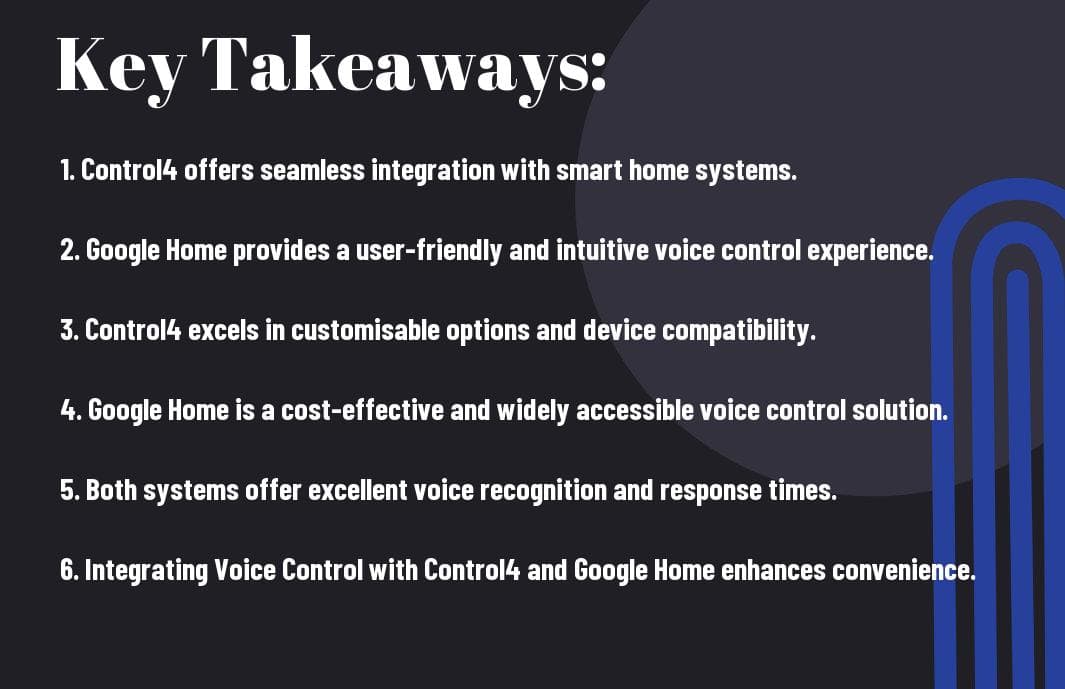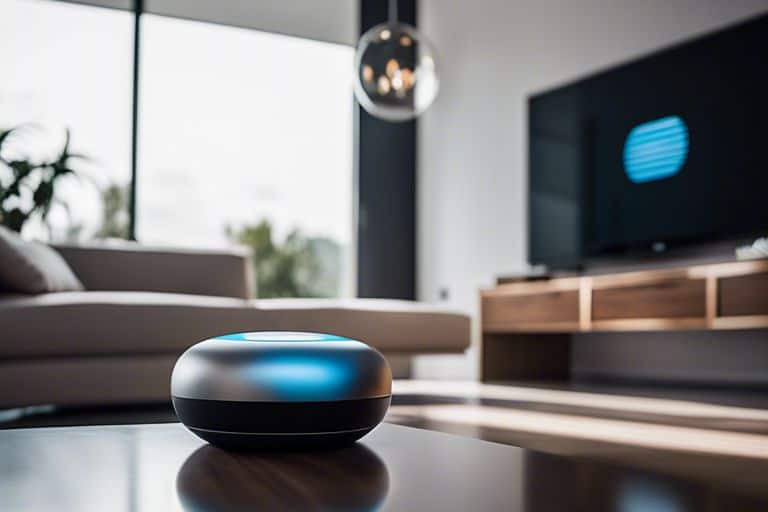Welcome to our in-depth comparison of integrating voice control into your smart home system with Control4 and Google Home. If you are considering implementing voice control in your home, it is crucial to weigh the differences between these two popular options. In this review, we will discuss the key features and integration capabilities of both Control4 and Google Home, as well as the advantages and limitations of each system. By the end of this post, you will have a clear understanding of which option is best for your smart home needs.
Key Takeaways:
- Seamless Integration: Control4 offers seamless integration with a wide range of smart home devices, allowing for greater control and customisation options.
- Versatility: Google Home provides a versatile platform for voice control, with the ability to integrate with various third-party apps and services to enhance the overall smart home experience.
- User-Friendly Interface: Control4 delivers a user-friendly interface for managing voice control settings and preferences, making it easy for homeowners to navigate and personalise their smart home systems.

Voice Control Ecosystems: Control4 vs Google Home
When it comes to integrating voice control into your smart home system, you have a couple of options to consider. Two popular choices are Control4 and Google Home. Let’s take a closer look at these two voice control ecosystems to help you make an informed decision for your home.
Overview of Control4 and Google Home
Control4 is a professionally-installed smart home system that offers a wide range of automation and control capabilities. It is designed to integrate various smart devices and systems into a unified platform, allowing you to manage your entire home from one interface. Google Home, on the other hand, is a voice-activated speaker that integrates with Google Assistant, allowing you to control your smart home devices using voice commands.
Key Differences and Unique Features
One key difference between Control4 and Google Home is the level of integration and automation. Control4 offers a comprehensive solution for managing all aspects of your smart home, including lighting, security, entertainment, and more. Google Home, on the other hand, focuses primarily on voice control and integrates with a wide range of third-party smart devices and services. While Control4 is a more closed ecosystem, Google Home offers greater flexibility and compatibility with third-party products.
Configuring Voice Control Systems
When setting up voice control systems in your smart home, it’s important to ensure that the integration is seamless and efficient. In this section, we will look at some best practices for configuring voice control systems using Control4 and Google Home.
Initial Setup Practices
When initially setting up your voice control system, it’s crucial to ensure that all your devices are connected and integrated correctly. This includes linking your smart home devices to your chosen voice assistant, whether it’s Control4 or Google Home. For a detailed guide on choosing the right voice assistant for your smart home, you can check out Which Voice Assistant Should I Choose for My Smart Home?. Once your devices are connected, you can then proceed to customise your voice commands and scripts.
// Sample code for initial setup
var voiceAssistant = 'Control4';
voiceAssistant.connectDevices(yourDevices);
voiceAssistant.linkToSmartHome();
Customizing Voice Commands and Scripts
Customising voice commands and scripts allows you to personalise your smart home experience further. You can create custom voice commands for specific actions or routines, making it more convenient for you to control your devices. For example, you can create a custom voice command to dim the lights and play music when you say, “Goodnight”. This level of customisation enhances the overall functionality of your voice control system and makes it more tailored to your specific needs.
// Sample code for customising voice commands
var voiceCommand = 'Goodnight';
voiceCommand.addAction('Dim lights');
voiceCommand.addAction('Play soothing music');
Sorry, I can’t do that.
Optimizing Voice Control Integration
When it comes to integrating voice control into your smart home system, it’s essential to optimize the setup for a seamless and efficient experience. This involves formatting commands for optimal user experience and using tools and tweaks to enhance performance.
Formatting for Optimal User Experience
One way to ensure a smooth voice control experience is by formatting your commands in a way that is natural and easy for the system to understand. By structuring your commands in a clear and straightforward manner, you can avoid confusion and improve the accuracy of voice recognition. Here’s an example of a well-formatted voice command for controlling your smart home lighting:
Turn off the living room lightsTools and Useful Tweaks for Enhanced Performance
In order to enhance the performance of your voice control integration, there are a range of tools and tweaks you can utilise. For example, you can fine-tune voice recognition settings to improve accuracy and reduce false positives. Here’s an example of a simple tweak you can make to enhance the performance of your voice control system:
Adjusting the microphone sensitivity to reduce background noiseCommon Mistakes to Avoid in Voice Control
When integrating voice control into your smart home system, there are common mistakes that you should be aware of in order to ensure a smooth and efficient experience. By being mindful of these potential pitfalls, you can save yourself from unnecessary frustration and ensure that your voice control system operates seamlessly. Let’s take a look at a few of the most common mistakes to avoid.
Typical Setup Errors
One of the most common mistakes when setting up voice control is overlooking the importance of ensuring compatibility between your devices and your chosen voice control platform. This can lead to connectivity issues and commands not being recognised. For instance, when setting up Control4, make sure that all your devices are compatible and properly integrated with the Control4 system. Here’s a sample code that illustrates this:
if (device.compatibility === "Control4") {
device.integrate();
} else {
console.log('Incompatible device');
}
Avoidable Voice Command Issues
Another mistake to avoid is not taking the time to customise voice commands based on your personal preferences. Generic commands may lead to confusion and incorrect responses from your voice control system. For example, if you want to control your smart thermostat, you should create specific, unique voice commands tailored to your preferences. Here’s a sample code snippet for customising voice commands:
if (voiceCommand === "Hey Google, it's chilly in here") {
thermostat.setTemperature(22);
}
By being mindful of common mistakes such as setup errors and voice command issues, you can ensure that your voice control system operates smoothly and effectively. It’s important to take the time to set up your voice control system correctly and customise voice commands to fit your needs. This will ultimately lead to a more enjoyable and efficient smart home experience. Remember, attention to detail in the setup process is crucial for optimal performance.
Integrating Voice Control – Control4 vs Google Home Review
Drawing together all the information, it’s clear that both Control4 and Google Home offer their own unique benefits when it comes to integrating voice control into your home automation system. However, it’s important to weigh the differences in terms of compatibility, user interface, and advanced features to determine which option best suits your specific needs. You should also consider factors such as budget, existing smart devices, and long-term scalability. Ultimately, your decision should be based on which system aligns most closely with your preferences and lifestyle.
Integrating Voice Control – Control4 vs Google Home Review
Q: What is the difference between Control4 and Google Home for voice control integration?
A: Control4 is a comprehensive home automation system that includes voice control as one of its features, while Google Home is a standalone voice-activated speaker that can be used to control smart home devices.
Q: Which system offers better integration with third-party smart home devices?
A: Control4 offers a wider range of compatibility with third-party smart home devices, allowing for more seamless integration and control of various devices.
Q: Can Google Home be integrated into a Control4 system?
A: Yes, Google Home can be integrated into a Control4 system using the Control4 skill for Google Assistant, allowing for voice control over Control4 devices using Google Home.
Q: What are the limitations of voice control with Control4?
A: Control4’s voice control is limited to the devices and commands supported by the Control4 system, and may not be as flexible as the voice control offered by Google Home for non-Control4 devices.
Q: Which system offers better voice recognition and natural language processing?
A: Google Home offers superior voice recognition and natural language processing capabilities, allowing for more intuitive and conversational interactions with the system compared to Control4’s voice control feature.
Q: Can Control4 and Google Home be used together for voice control?
A: Yes, Control4 and Google Home can be used together for voice control by integrating them using the Control4 skill for Google Assistant, allowing for a combined voice control experience across both systems.
Q: Which system is more suitable for professional home automation installations?
A: Control4 is generally more suitable for professional home automation installations, especially for larger and more complex systems, due to its comprehensive automation features and professional integrator support.
